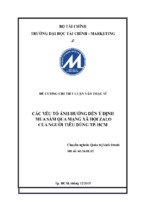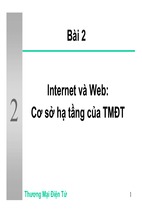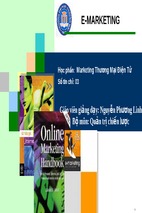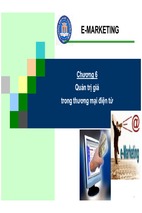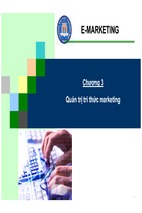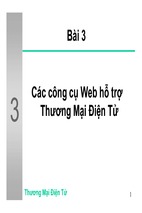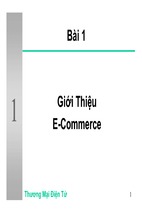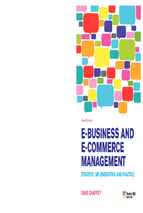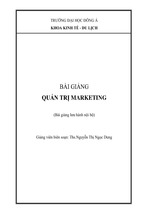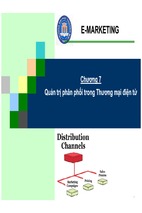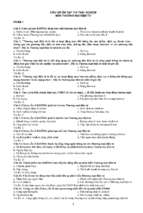Tài liệu phục vụ học môn Thương mại điện tử
Ben Clegg, Aston Business School
‘This text provides a strong strategic framework to help
students understand this fast-moving subject, as well as
a useful guide to practical analysis.’
Mette Præst Knudsen, University of Southern Denmark
What approach to e-business strategy should you follow? How much do you need to
invest in e-business? Which processes should be your priorities?
Written in an engaging and informative style, E-Business and E-Commerce Management explores these
questions, equipping you with the knowledge and skills to navigate today’s fast-paced world of continuous
technological development.
In this latest edition of his bestselling text, leading authority Dave Chaffey brings together the latest academic
thinking and professional practice. Covering all aspects of e-business including strategy, digital marketing and
supply chain management, E-Business and E-Commerce Management gives you the benefit of:
• A structured approach to planning, implementing, assessing and improving
e-business strategy for all types of organization.
The
latest on managing e-business security and cutting edge e-marketing
•
techniques such as social media and search engine optimization.
• Case studies of technology leaders such as Dell, Facebook and Google,
as well as start-ups and small businesses.
• Real-life interviews with professionals who describe their e-business strategies.
Dave Chaffey (www.davechaffey.com) is an e-business consultant and visiting lecturer on e-business
courses at Warwick University and Cranfield School of Management.
Additional learning resources are online at
www.pearsoned.co.uk/chaffey
An imprint of
CVR_CHAFF9601_04_SE_CVR.indd 1
www.pearson-books.com
Fourth
Edition
Chaffey
Whether you’re an undergraduate or postgraduate student studying e-business and e-commerce, or
a business manager, E-Business and E-Commerce Management is the essential text to help you keep
pace with technology, strategy and implementation.
E-Business and
E-Commerce Management
‘This book keeps getting better and better with every version. It is fast
becoming the de facto standard for e-business and e-commerce – for
both faculty and students.’
Fourth Edition
E-Business and
E-Commerce
Management
Strategy, Implementation and Practice
Dave Chaffey
8/4/09 09:31:49
A01_CHAF9601_04_SE_FM.QXD:D01_CHAF7409_04_SE_C01.QXD
16/4/09
15:29
Page i
E-Business and
E-Commerce
Management
Strategy, Implementation and Practice
Visit the E-Business and E-Commerce Management, fourth edition Companion Website at
www.pearsoned.co.uk/chaffey to find valuable student learning material including:
� A study guide to reinforce key ideas and topics
� Multiple choice questions to test your learning
� Links to relevant sites on the web
� An online glossary to explain key terms
� Flashcards to test your understanding of key terms
� A smarter online searching guide
� Link to Dave Chaffey’s blog with a collection of articles and links
� Link to Dave Chaffey’s Twitter feed
A01_CHAF9601_04_SE_FM.QXD:D01_CHAF7409_04_SE_C01.QXD
16/4/09
10:59
We work with leading authors to develop the
strongest educational materials in business and
management, bringing cutting-edge thinking and
best learning practice to a global market.
Under a range of well-known imprints, including
Financial Times Prentice Hall we craft high quality
print and electronic publications which help readers
to understand and apply their content, whether
studying or at work.
To find out more about the complete range of our
publishing, please visit us on the World Wide Web at:
www.pearsoned.co.uk
Page ii
A01_CHAF9601_04_SE_FM.QXD:D01_CHAF7409_04_SE_C01.QXD
16/4/09
10:59
Page iii
Fourth Edition
E-BUSINESS AND
E-COMMERCE
MANAGEMENT
STRATEGY, IMPLEMENTATION AND PRACTICE
Dave Chaffey
A01_CHAF9601_04_SE_FM.QXD:D01_CHAF7409_04_SE_C01.QXD
16/4/09
10:59
Page iv
Pearson Education Limited
Edinburgh Gate
Harlow
Essex CM20 2JE
England
and Associated Companies throughout the world
Visit us on the World Wide Web at:
www.pearsoned.co.uk
First published 2002
Second edition published 2004
Third edition published 2007
Fourth edition published 2009
© Dave Chaffey 2002
© Marketing Insights Limited 2002, 2009
The right of Dave Chaffey to be identified as author of this work has
been asserted by him in accordance with the Copyright, Designs and Patents Act 1988.
All rights reserved. No part of this publication may be reproduced, stored in a retrieval
system, or transmitted in any form or by any means, electronic, mechanical,
photocopying, recording or otherwise, without either the prior written permission of the
publisher or a licence permitting restricted copying in the United Kingdom issued by the
Copyright Licensing Agency Ltd, Saffron House, 6–10 Kirby Street, London EC1N 8TS.
All trademarks used herein are the property of their respective owners. The use of any
trademark in this text does not vest in the author or publisher any trademark ownership rights
in such trademarks, nor does the use of such trademarks imply any affiliation with or
endorsement of this book by such owners.
ISBN: 978-0-273-71960-1
British Library Cataloguing-in-Publication Data
A catalogue record for this book is available from the British Library
Library of Congress Cataloging-in-Publication Data
Chaffey, Dave, 1963–
E-business and e-commerce management : strategy, implementation, and
practice / Dave Chaffey. -- 4th ed.
p. cm.
Includes bibliographical references and index.
ISBN 978-0-273-71960-1 (pbk. : alk. paper) 1. Electronic commerce.
2. Business enterprises--Computer networks. I. Title. II. Title:
Ebusiness and ecommerce management.
HF5548.32.C472 2009
658.8'72--dc22
2009009561
10 9 8 7 6 5 4 3 2 1
13 12 11 10 09
Typeset in 10/12pt Minion by 30
Printed and bound by Rotolito Lombarda, Italy
The publisher’s policy is to use paper manufactured from sustainable forests.
A01_CHAF9601_04_SE_FM.QXD:D01_CHAF7409_04_SE_C01.QXD
16/4/09
10:59
Page v
Brief contents
Preface
Guided tour
Author’s acknowledgements
Publishers acknowledgements
Part 1
Introduction
xiii
xxiv
xxvi
xxvii
1
1 Introduction to e-business and e-commerce
3
2 E-commerce fundamentals
Part 2
Part 3
51
3 E-business infrastructure
103
4 E-environment
192
Strategy and applications
253
5 E-business strategy
255
6 Supply chain management
330
7 E-procurement
380
8 E-marketing
412
9 Customer relationship management
481
Implementation
559
10 Change management
560
11 Analysis and design
604
12 Implementation and maintenance
680
Glossary
Index
736
754
A01_CHAF9601_04_SE_FM.QXD:D01_CHAF7409_04_SE_C01.QXD
16/4/09
10:59
Page vi
A01_CHAF9601_04_SE_FM.QXD:D01_CHAF7409_04_SE_C01.QXD
16/4/09
10:59
Page vii
Contents
Preface
Guided tour
About the author
Author’s acknowledgements
Publisher’s acknowledgements
xiii
xxiv
xxvi
xxvii
xxvii
Introduction
52
Real-world E-Business: More Th>n
53
The e-commerce environment
57
Strategic agility
57
Online marketplace analysis
59
Location of trading in the marketplace
67
The importance of multi-channel marketplace
models
70
Different types of online intermediary
71
Types of intermediaries
74
The importance of search engines
76
Business models for e-commerce
77
Revenue models
79
Online publisher and intermediary revenue models 80
Focus on auction business models
86
Case Study 2.1 The impact of B2B reverse
auctions
87
Focus on Internet start-up companies
88
From ‘bricks and mortar’ to ‘clicks and mortar’
88
Assessing e-businesses
89
Valuing Internet start-ups
89
Case Study 2.2 lastminute.com – an international
dot-com survivor
91
The dot-com bubble bursts
93
Why dot-coms failed
93
The impact of the dot-com phenomenon on
traditional organizations
95
Case Study 2.3 Zopa launches a new lending
model
95
Summary
98
Exercises
99
References
100
Further reading
101
Web links
101
Part 1
Introduction
1
Introduction to e-business and e-commerce
Learning outcomes / Management issues
Links to other chapters
Introduction
The impact of the electronic communications on
traditional businesses
Real-world E-Business: HP.com
What is the difference between e-commerce and
e-business?
E-commerce defined
E-business defined
Case Study 1.1 A short history of Facebook
Business or consumer models of e-commerce
transactions
E-business opportunities
Business adoption of digital technologies for
e-commerce and e-business
Drivers of business Internet adoption
Case Study 1.2 North West Supplies extends its
reach online
E-business risks and barriers to business adoption
Evaluating an organization’s e-business capabilities
Drivers of consumer Internet adoption
Barriers to consumer Internet adoption
Management responses to e-commerce and
e-business
Part 1: Introduction
Part 2: Strategy and applications
Part 3: Implementation
Case Study 1.3 eBay – the world’s largest
e-business
Summary
Exercises
References
Further reading
Web links
2
E-commerce fundamentals
Learning outcomes / Management issues
Links to other chapters
1
3
3
3
4
6
7
9
10
13
17
26
29
30
30
33
35
36
37
39
39
39
40
42
42
46
46
48
49
49
51
51
51
3
E-business infrastructure
Learning outcomes / Management issues
Links to other chapters
Introduction
E-business infrastructure components
Real-world E-Business: Random House
Internet technology
Hosting of web sites and e-business services
The Internet timeline
Just how big is the Internet?
Case Study 3.1 Innovation at Google
Intranets and extranets
Web technology
Internet-access software applications
Blogs and blogging
Electronic mail or e-mail
Feeds
Voice over IP (VoIP)
103
103
103
104
105
107
109
110
111
114
115
116
124
128
129
131
132
134
A01_CHAF9601_04_SE_FM.QXD:D01_CHAF7409_04_SE_C01.QXD
viii
4
16/4/09
10:59
Page viii
Contents
How does it work? Internet standards
Networking standards
The HTTP protocol
Uniform resource locators (URLs)
Domain names
Web presentation and data exchange standards
Audio and video standards
Focus on Internet governance
Managing e-business infrastructure
Managing hardware and systems software
infrastructure
Managing Internet service and hosting providers
Managing employee access to the Internet and
e-mail
Managing e-business applications infrastructure
Focus on web services, SaaS and service-oriented
architecture (SOA)
Benefits of web services or SaaS
Challenges of deploying SaaS
Case Study 3.2 New architecture or just new
hype?
EDI
Focus on mobile commerce
Wireless Internet access standards
Wireless access devices
Popularity of mobile applications
Summary
Exercises
References
Further reading
Web links
136
136
138
139
139
141
152
152
158
E-environment
192
192
192
193
196
198
198
209
222
Learning outcomes / Management issues
Links to other chapters
Introduction
Real-world E-Business: GD Worldwide
Social and legal factors
Factors governing e-commerce service adoption
Privacy and trust in e-commerce
Other e-commerce legislation
Environmental and green issues related to Internet
usage
Taxation
Freedom-restrictive legislation
Economic and competitive factors
Focus on e-commerce and globalization
Case Study 4.1 The implications of globalization
for consumer attitudes
The implications of e-commerce for international
B2B trading
Political factors
Internet governance
E-government
Technological innovation and technology assessment
Approaches to identifying emerging technology
Summary
Exercises
References
159
160
165
165
168
168
169
174
176
177
178
179
179
186
187
188
190
190
227
229
231
232
233
235
236
238
239
240
241
244
246
246
247
249
249
Further reading
Web links
Part 2
Strategy and applications
5
253
E-business strategy
Learning outcomes / Management issues
Links to other chapters
Introduction
Real-world E-Business: Standard Life
What is e-business strategy?
The imperative for e-business strategy
E-channel strategies
Strategy process models for e-business
Strategic analysis
Resource and process analysis
Competitive environment analysis
Assessing competitive threats
Co-opetion
Competitor analysis
Strategic objectives
Defining vision and mission
How can e-business create business value?
Case Study 5.1 Capital One creates value
through e-business
Objective setting
Case Study 5.2 Setting the Internet revenue
contribution at Sandvik Steel
Strategy definition
Decision 1: E-business channel priorities
Decision 2: Market and product development
strategies
Decision 3: Positioning and differentiation
strategies
Decision 4: Business, service and revenue models
Decision 5: Marketplace restructuring
Decision 6: Supply-chain management capabilities
Decision 7: Internal knowledge management
capabilities
Decision 8: Organizational resourcing and
capabilities
Strategy implementation
Failed e-business strategies
E-business strategy implementation success
factors for SMEs
Case Study 5.3 Boo hoo – learning from the
largest European dot-com failure
Focus on information systems strategy and
e-business strategy
Elements of IS strategy
Investment appraisal
Summary
Exercises
References
Further reading
Web links
255
255
255
256
256
259
261
262
264
269
269
276
276
281
281
281
282
285
286
287
292
295
298
300
303
306
308
309
310
310
313
314
315
316
319
320
320
324
325
326
328
329
A01_CHAF9601_04_SE_FM.QXD:D01_CHAF7409_04_SE_C01.QXD
16/4/09
10:59
Page ix
Contents
6
Supply chain management
Learning outcomes / Management issues
Links to other chapters
Introduction
Problems of supply chain management
What is supply chain management?
Using technology to support supply chain
management – an example
A simple model of a supply chain
Case Study 6.1 Shell chemicals redefines its
customers’ supply chains
What is logistics?
Push and pull supply chain models
Focus on the value chain
Restructuring the internal value chain
The value stream
Value chain analysis
Value networks
Towards the virtual organization
Options for restructuring the supply chain
Using e-business to restructure the supply chain
Technology options and standards for supply
chain management
Adoption rates of e-business applications
Case Study 6.2 Tesco develops a buy-side
e-commerce system for supply chain management
IS-supported downstream supply chain
management
Outbound logistics management
IS infrastructure for supply chain management
Supply chain management implementation
Data standardization and exchange
Human resources requirements of SCM
The supply chain management strategy process
Managing partnerships
Managing global distribution
Case Study 6.3 RFID: keeping track starts its
move to a faster track
Summary
Exercises
References
Further reading
Web links
7
E-procurement
Learning outcomes / Management issues
Links to other chapters
Introduction
What is e-procurement?
Understanding the procurement process
Types of procurement
Participants in online procurement
Drivers of e-procurement
Case Study 7.1 Cambridge Consultants reduce
costs through e-procurement
Focus on estimating e-procurement cost
The impact of cost savings on profitability
Risks and impacts of e-procurement
330
330
330
331
334
335
337
340
341
345
347
348
350
351
351
352
354
356
358
359
360
363
365
365
366
368
368
369
371
372
374
374
375
376
377
379
379
380
380
380
381
381
384
385
386
387
388
390
391
392
8
ix
Organizational risks
Failure to achieve real cost reductions
Technology risks
Implementing e-procurement
The growth in adoption of web-enabled
e-procurement
Integrating company systems with supplier
systems
Focus on electronic B2B marketplaces
Case Study 7.2 Covisint – a typical history of a
B2B marketplace?
Types of marketplace
The future of e-procurement?
Summary
Exercises
References
Further reading
Web links
393
393
394
394
E-marketing
412
412
412
413
414
415
416
416
417
Learning outcomes / Management issues
Links to other chapters
Introduction
Chapter structure
Real-world E-Business: Guess
What is e-marketing?
Marketing defined
E-marketing defined
Distinguishing between e-marketing, e-business
and e-commerce
E-marketing planning
Is a separate e-marketing plan required?
Situation analysis
Demand analysis
Competitor analysis
Intermediary analysis
Internal marketing audit
Objective setting
Case Study 8.1 The e-volution of easyJet’s online
revenue contribution
Strategy
Market and product positioning
Target market strategies
Focus on characteristics of new-media marketing
communications
Tactics
Product
Case Study 8.2 Dell gets closer to its customers
online
Price
Place
Promotion
People, Process and Physical evidence
Focus on online branding
The importance of brand online
Actions
Control
Case Study 8.3 The new Napster changes the
music marketing mix
396
397
400
403
405
407
407
408
409
410
410
417
418
418
420
421
425
427
428
428
431
433
436
437
443
448
451
453
456
460
462
464
464
467
469
470
471
A01_CHAF9601_04_SE_FM.QXD:D01_CHAF7409_04_SE_C01.QXD
x
16/4/09
10:59
Page x
Contents
Summary
Exercises
References
Further reading
Web links
475
476
477
479
480
Customer relationship management
481
481
481
482
483
484
486
487
488
490
491
492
493
Part 3
Implementation
559
10 Change management
9
Learning outcomes / Management issues
Links to other chapters
Introduction
Marketing applications of CRM
Real-world E-Business: Warner Breaks
What is e-CRM?
Benefits of e-CRM
Permission marketing
Customer profiling
Conversion marketing
The online buying process
Differences in buyer behaviour in target markets
Differences between B2C and B2B buyer
behaviour
The net promoter score
Customer acquisition management
Focus on marketing communications for customer
acquisition
The characteristics of interactive marketing
communications
Assessing marketing communications effectiveness
Online marketing communications
Customer retention management
Personalization and mass customization
Online communities
Techniques for managing customer activity and
value
Lifetime value modelling
Focus on excelling in e-commerce service quality
Improving online service quality
Customer extension
Advanced online segmentation and targeting
techniques
Technology solutions for CRM
Types of CRM applications
Integration with back-office systems
The choice of single-vendor solutions or a more
fragmented choice
Data quality
Case Study 9.1 Tesco.com increases product
range and uses triggered communications to
support CRM
Summary
Exercises
References
Further reading
Web links
493
495
498
498
499
502
503
526
528
530
533
534
536
536
539
540
546
547
547
548
549
549
552
552
553
556
557
Learning outcomes / Management issues
Links to other chapters
Introduction
The challenges of e-business transformation
The challenges of sell-side e-commerce
implementation
Different types of change in business
Case Study 10.1 Process management: making
complex business simpler
Planning change
The imperative for project governance?
The project plan and schedule for an e-business
system
Prototyping
Human resource requirements
Staff retention
Outsourcing
Revising organizational structures
Approaches to managing change
Senior management involvement
Models for achieving change
Organizational culture
Focus on knowledge management
What is knowledge?
Objectives of knowledge management
Implementing knowledge management
Technologies for implementing knowledge
management
Case Study 10.2 Using Web 2.0 tools to support
knowledge management at Janssen-Cillag Australia
Risk management
Summary
Exercises
References
Further reading
Web links
11 Analysis and design
Learning outcomes / Management issues
Links to other chapters
Introduction
Real-world E-Business: Arena Flowers
Analysis for e-business
Workflow management
Process modelling
Process mapping
Task analysis and task decomposition
Process dependencies
Validating a new process model
560
560
560
561
561
563
566
570
572
572
574
576
579
580
581
583
586
586
586
588
590
590
592
593
594
596
598
600
600
601
603
603
604
604
604
605
606
608
609
610
610
610
612
618
A01_CHAF9601_04_SE_FM.QXD:D01_CHAF7409_04_SE_C01.QXD
16/4/09
10:59
Page xi
Contents
Data modelling
Design for e-business
Architectural design of e-business systems
Focus on user-centred site design
Use-case analysis
Designing the information architecture
Customer orientation
Elements of site design
Web accessibility
Case Study 11.1 Dabs.com refines its web store
Focus on security design for e-business
Managing computer viruses
Controlling information service usage
Monitoring of electronic communications
E-mail management
Hacking
Secure e-commerce transactions
Approaches to developing secure systems
Current approaches to e-commerce security
Reassuring the customer
Case Study 11.2 Building an e-business fortress
Summary
Exercises
References
Further reading
Web links
12 Implementation and maintenance
Learning outcomes / Management issues
Links to other chapters
Introduction
Real-world E-Business: Thomas Cook
Alternatives for acquiring e-business systems
Development of web-based content and services
619
621
621
623
627
634
639
641
646
649
652
658
660
660
665
669
671
671
673
674
674
675
676
677
679
679
680
680
680
681
682
684
686
Creating static web content
Software and services for web-site development
and testing
Testing
The testing process
Testing environments
Changeover
Database creation and data migration
Deployment planning
Content management and maintenance
Frequency and scope of content updating
Maintenance process and responsibilities
Focus on measuring and improving performance of
e-business systems
Principles of performance management and
improvement
Stage 1: Creating a performance management
system
Stage 2: Defining the performance metrics
framework
Stage 3: Tools and techniques for collecting
metrics and summarizing results
Budgeting
Case Study 12.1 Learning from Amazon’s culture
of metrics
Summary
Exercises
References
Further reading
Web links
Glossary
Index
xi
686
689
694
694
695
695
696
697
697
697
699
703
704
705
706
711
724
726
732
732
733
734
735
736
754
A01_CHAF9601_04_SE_FM.QXD:D01_CHAF7409_04_SE_C01.QXD
16/4/09
10:59
Page xii
Supporting resources
Visit www.pearsoned.co.uk/chaffey to find valuable online resources
Companion Website for students
� A study guide to reinforce key ideas and topics
� Multiple choice questions to test your learning
� Links to relevant sites on the web
� An online glossary to explain key terms
� Flashcards to test your understanding of key terms
� A smarter online searching guide
� Link to Dave Chaffey’s blog with a collection of articles and links
� Link to Dave Chaffey’s Twitter feed
For instructors
� Complete, downloadable Instructor’s Manual
� PowerPoint slides that can be downloaded and used for presentations
� Testbank of question material
Also: The Companion Website provides the following features:
� Search tool to help locate specific items of content
� E-mail results and profile tools to send results of quizzes to instructors
� Online help and support to assist with website usage and troubleshooting
For more information please contact your local Pearson Education sales representative or visit
www.pearsoned.co.uk/chaffey
A01_CHAF9601_04_SE_FM.QXD:D01_CHAF7409_04_SE_C01.QXD
16/4/09
10:59
Page xiii
Preface
In 1849 a group of settlers travelling west towards the promised land, California, entered a
then unnamed valley. The valley presented a harsh environment with a barrier of mountains
to the west making the way forward unclear. Some of the settlers lost their lives as they
sought to find a route west before eventually reaching California and what was to become
one of the most prosperous places on Earth. As the group left the valley, one of the women
in the group turned and said ‘Goodbye, Death Valley’ and hence the valley got its name. The
route to e-business success is also not straightforward and similarly fraught with difficulties
of selecting the correct strategic direction and surviving in an increasingly harsh competitive
environment. Not all who follow the route survive. However, the competitive drivers to
follow this route, such as demand from customers and adoption by competitors, make this
journey essential. The rewards are evident from those adopters who identified the opportunity early and steered their companies in the right direction.
But the journey to e-business can never be completed, because of the relentless evolution
in technology and new commercial approaches which exploit it. Smart e-businesses have an
agile approach which enables them to review and select the appropriate technologies at the
right time.
Flagship e-businesses with headquarters in California such as eBay and Google.com are
now leading global brands with turnovers of billions of dollars, yet this has happened less
than 300 years after the first modern settlers arrived.
This book is intended to equip current and future managers with some of the knowledge
and practical skills to help them navigate their organization towards e-business. It is your
guide to how all types of companies can prosper through e-business.
A primary aim of this book is to identify and review the key management decisions
required by organizations moving to e-business and consider the process by which these
decisions can be taken. Key questions are the following: What approach to e-business strategy do we follow? How much do we need to invest in e-business? Which processes should be
our e-business priorities? Should we adopt new business and revenue models? What are the
main changes that need to be made to the organization to facilitate e-business?
Given the broad scope of e-business, this book takes an integrative approach drawing on
new and existing approaches and models from many disciplines including information systems, strategy, marketing, supply and value chain management, operations and human
resources management.
What is e-business management?
Electronic
commerce
(e-commerce)
All electronically mediated
information exchanges
between an organization
and its external stakeholders.
As we will see in Chapter 1, electronic business (e-business) is aimed at enhancing the competitiveness of an organization by deploying innovative information and communications
technology throughout an organization and beyond, through links to partners and customers.
It does not simply involve using technology to automate existing processes, but should also
achieve process transformation by applying technology to help change these processes. To be
successful in managing e-business, a breadth of knowledge is needed of different business
processes and activities from across the value chain such as marketing and sales, through new
product development, manufacturing and inbound and outbound logistics. Organizations
also need to manage the change required by new processes and technology through what have
traditionally been support activities such as human resources management.
A01_CHAF9601_04_SE_FM.QXD:D01_CHAF7409_04_SE_C01.QXD
xiv
16/4/09
10:59
Page xiv
Preface
Supply chain management (SCM)
The coordination of all
supply activities of an
organization from its
suppliers and partners to
its customers.
From this definition, it is apparent that e-business involves looking at how electronic
communications can be used to enhance all aspects of an organization’s supply chain management. It also involves optimizing an organization’s value chain, a related concept that
describes the different value-adding activities that connect a company’s supply side with its
demand side. The e-business era also involves management of a network of interrelated
value chains or value networks.
What is e-commerce management?
Electronic
commerce
(e-commerce)
All electronically mediated
information exchanges
between an organization
and its external stakeholders.
Value chain
A model for analysis of
how supply chain activities can add value to
products and services
delivered to the customer.
Value networks
The links between an
organization and its
strategic and nonstrategic partners that
form its external value
chain.
To this point we have exclusively used the term ‘e-business’, but what of ‘e-commerce’? Both
these terms are applied in a variety of ways; to some they mean the same, to others they are
quite different. As explained in Chapter 1, what is most important is that they are applied
consistently within organizations so that employees and external stakeholders are clear
about how the organization can exploit electronic communications. The distinction made in
this book is to use ‘electronic commerce’ (e-commerce) to refer to all types of electronic
transactions between organizations and stakeholders whether they are financial transactions
or exchanges of information or other services. These e-commerce transactions are either
buy-side e-commerce or sell-side e-commerce and the management issues involved with
each aspect are considered separately in Part 2 of the book. ‘E-business’ is applied as a
broader term encompassing e-commerce but also including all electronic transactions
within an organization.
Management of e-commerce involves prioritizing buy-side and sell-side activities and
putting in place the plans and resources to deliver the identified benefits. These plans need
to focus on management of the many risks to success, some of which you may have experienced when using e-commerce sites, from technical problems such as transactions that fail,
sites that are difficult to use or are too slow, through to problems with customer service or
fulfilment, which also indicate failure of management.
How is this book structured?
Electronic business
(e-business)
All electronically mediated
information exchanges,
both within an organization and with external
stakeholders supporting
the range of business
processes.
Buy-side
e-commerce
E-commerce transactions
between an organization
and its suppliers and
other partners.
Sell-side
e-commerce
E-commerce transactions
between an organization
and its customers.
The overall structure of the book shown in Figure P.1 follows a logical sequence: introducing
e-business terms, concepts and history of development in Part 1; reviewing alternative
strategic approaches and applications of e-business in Part 2; and how strategy can be
implemented in Part 3. Within this overall structure, differences in how electronic communications are used to support different business processes are considered separately. This
is achieved by distinguishing between how electronic communications are used, from buyside e-commerce aspects of supply chain management in Chapters 6 and 7, to the marketing
perspective of sell-side e-commerce in Chapters 8 and 9. Figure P.1 shows the emphasis of
perspective for the particular chapters.
Part 1: Introduction (Chapters 1–4)
Part 1 introduces e-business and e-commerce. It seeks to clarify basic terms and concepts by
looking at different interpretations of terms and applications through case studies.
�
Chapter 1: Introduction to e-business and e-commerce. Definition of the meaning and scope
of e-business and e-commerce. Introduction to business use of the Internet – what are the
benefits and barriers to adoption and how widely used is it?
A01_CHAF9601_04_SE_FM.QXD:D01_CHAF7409_04_SE_C01.QXD
16/4/09
10:59
Page xv
Preface
xv
Part 1 INTRODUCTION
Chapter 1
Introduction to
e-business and
e-commerce
Chapter 2
E-commerce
fundamentals
Chapter 3
E-business
infrastructure
Chapter 4
E-environment
Part 2 STRATEGY AND APPLICATIONS
Chapter 5
E-business
strategy
Chapter 6
Supply chain
management
Chapter 7
E-procurement
Chapter 8
E-marketing
Chapter 9
Customer
relationship
management
Part 3 IMPLEMENTATION
Chapter 10
Change
management
Chapter 11
Analysis
and design
Chapter 12
Implementation
and
maintenance
Key
Sell-side e-commerce emphasis
E-business emphasis
Figure P.1
�
�
�
Structure of the book
Chapter 2: E-commerce fundamentals. Introduction to new business models and marketplace
structures enabled by electronic communications.
Chapter 3: E-business infrastructure. Background on the hardware, software and
telecommunications that need to be managed to achieve e-business.
Chapter 4: E-environment. Describes the macro-environment of an organization that presents
opportunities and constraints on strategy and implementation.
Part 2: Strategy and applications (Chapters 5–9)
In Part 2 of the book approaches to developing e-business strategy and applications are
reviewed for the organization as a whole (Chapter 5) and with an emphasis on buy-side
e-commerce (Chapters 6 and 7) and sell-side e-commerce (Chapters 7 and 8).
�
�
�
�
�
Chapter 5: E-business strategy. Approaches to developing e-business strategy. Differences
from traditional strategic approaches. Relation to IS strategy.
Chapter 6: Supply chain management. A supply chain perspective on strategy with examples
of how technology can be applied to increase supply chain and value chain efficiency.
Chapter 7: E-procurement. Evaluation of the benefits and practical issues of adopting
e-procurement.
Chapter 8: E-marketing. A sell-side e-commerce perspective to e-business, reviewing
differences in marketing required through digital media. Structured around developing an
e-marketing plan.
Chapter 9: Customer relationship management. Reviews marketing techniques that apply
e-commerce for acquiring and retaining customers.
A01_CHAF9601_04_SE_FM.QXD:D01_CHAF7409_04_SE_C01.QXD
xvi
16/4/09
10:59
Page xvi
Preface
Part 3: Implementation (Chapters 10–12)
Management of e-business implementation is described in Part 3 of the book in which we examine practical management issues involved with creating and maintaining e-business solutions.
�
�
�
Chapter 10: Change management. How to manage the organizational, human and technology
changes required in the move to e-business.
Chapter 11: Analysis and design. We discuss the main issues of analysis and design raised
by e-commerce systems that need to be discussed by managers and solutions providers.
Chapter 12: Implementation and maintenance. How should e-commerce systems be managed
and monitored once they are live?
Who should use this book?
Students
This book has been created as the main student text for undergraduate and postgraduate
students taking specialist courses or modules which cover e-business, e-commerce information systems or e-marketing. The book is relevant to students who are:
�
�
�
�
undergraduates on business programmes which include modules on the use of the Internet
and e-commerce. This includes specialist degrees such as electronic business, electronic
commerce, Internet marketing and marketing or general business degrees such as business
studies, business administration and business management;
undergraduate project students who select this topic for final-year projects or dissertations
– this book is an excellent source of resources for these students;
undergraduates completing work placement involved with different aspects of e-business
such as managing an intranet or company web site;
postgraduate students on specialist masters degrees in electronic commerce, electronic business or
e-marketing and generic MBA, Certificate in Management, Diploma in Management Studies
which involve modules or electives for electronic commerce and digital marketing.
What does the book offer to lecturers teaching these courses?
The book is intended to be a comprehensive guide to all aspects of deploying e-business and
e-commerce within an organization. The book builds on existing theories and concepts
and questions the validity of these models in the light of the differences between the Internet
and other media. The book references the emerging body of literature specific to e-business,
e-commerce and e-marketing. As such, it can be used across several modules. Lecturers will
find the book has a good range of case studies, activities and exercises to support their teaching. These activities assist in using the book for student-centred learning as part of directed
study. Web links given in the text and at the end of each chapter highlight key information
sources for particular topics.
Practitioners
There is also much of relevance in this book for the industry professional, including:
�
�
Senior managers and directors seeking to apply the right e-business and e-commerce
approaches to benefit their organization.
Information systems managers who are developing and implementing e-business and
e-commerce strategies.
A01_CHAF9601_04_SE_FM.QXD:D01_CHAF7409_04_SE_C01.QXD
16/4/09
10:59
Page xvii
Preface
�
�
�
xvii
Marketing managers responsible for defining an e-marketing strategy and implementing
and maintaining the company web site.
Supply chain, logistics and procurement managers wanting to see examples of best practice
in using e-commerce for supply chain management.
Technical project managers or webmasters who may understand the technical details of
building a site, but have a limited knowledge of business or marketing fundamentals.
Student learning features
A range of features have been incorporated into this book to help the reader get the most out
of it. They have been designed to assist understanding, reinforce learning and help readers
find information easily. The features are described in the order you will encounter them.
At the start of each chapter
�
�
�
�
�
�
Chapter at a glance: a list of main topics, ‘focus on’ topics and case studies.
Learning outcomes: a list describing what readers can learn through reading the chapter
and completing the activities.
Management issues: a summary of main issues or decisions faced by managers related to
the chapter topic area.
Web support: additional material on the Companion Web Site.
Links to other chapters: a summary of related topics in other chapters.
Introductions: succinct summaries of the relevance of the topic to marketing students and
practitioners together with content and structure.
In each chapter
�
�
�
�
�
�
�
�
�
Activities: short activities in the main text that develop concepts and understanding, often
by relating to student experience or through reference to web sites. Model answers are
provided to activities at the end of the chapter where applicable.
Case studies: real-world examples of issues facing companies that implement e-business.
Questions at the end of the case study highlight the main learning points from that case
study (see p. xx).
Real-world e-business experiences: interviews with e-commerce managers at a range of UK,
European and US-based organizations concerning the strategies they have adopted and
their approaches to strategy implementation.
Box features: these explore a concept in more detail or give an example of a principle
discussed in the text.
‘Focus on’ sections: more detailed coverage of specific topics of interest.
Questions for debate: suggestions for discussion of significant issues for managers involved
with the transformation required for e-business.
Definitions: when significant terms are first introduced the main text contains succinct
definitions in the margin for easy reference.
Web links: where appropriate, web addresses are given for further information, particularly
those to update information.
Chapter summaries: intended as revision aids and to summarize the main learning points
from the chapter.
At the end of each chapter
�
�
Self-assessment exercises: short questions which will test understanding of terms and concepts
described in the chapter.
Discussion questions: require longer essay-style answers discussing themes from the chapter,
and can be used for essays or as debate questions in seminars.
A01_CHAF9601_04_SE_FM.QXD:D01_CHAF7409_04_SE_C01.QXD
xviii
16/4/09
10:59
Page xviii
Preface
�
�
�
�
�
Essay questions: conventional essay questions.
Examination questions: typical short-answer questions found in exams and can also be
used for revision.
References: these are references to books, articles or papers referred to within the chapter.
Further reading: supplementary texts or papers on the main themes of the chapter. Where
appropriate a brief commentary is provided on recommended supplementary reading on
the main themes of the chapters.
Web links: these are significant sites that provide further information on the concepts and
topics of the chapter. All web site references within the chapter, for example company sites, are
not repeated here. The web site address prefix ‘http://’ is omitted from www links for clarity.
At the end of the book
�
�
Glossary: a list of all definitions of key terms and phrases used within the main text.
Index: all key words and abbreviations referred to in the main text.
Learning techniques
The book is intended to support a range of learning styles. It can be used for an active or
student-centred learning approach whereby students attempt the activities through reflecting on questions posed, answering questions and then comparing to a suggested answer at
the end of the chapter. Alternatively, students can proceed straight to suggested answers in a
more traditional learning approach, which still encourages reflection about the topic.
Module guide
The table below presents one mapping of how the book could be used in different weekly
lectures and seminars through the core eleven weeks of a module where the focus is on management issues of e-business and e-commerce.
A fullset of PowerPoint slides and accompanying notes to assist lecturers in preparing lectures is available on the lecturer’s side of the Companion Web Site.
Enhancements for the fourth edition
The effective chapter structure of previous editions has been retained, but many other
changes have been incorporated based on lecturer and student feedback. There are two main
new features. First, new case studies in boxes ‘Real-world e-business experiences – the Econsultancy interview’ are introduced at the start of most chapters. These are interviews
with e-commerce managers at a range of UK, European and US-based organizations concerning the strategies they have adopted and their approaches to strategy implementation.
Second, there are numbered boxes which explore a concept in more detail or give an example of a principle discussed in the text. There are also three major new case studies to
enable learning from brands that will be well-known personally to students in different
countries: Dell, Facebook and Google. To help accommodate these, less reference is given to
the running ‘B2C and B2B Company’ case.
A01_CHAF9601_04_SE_FM.QXD:D01_CHAF7409_04_SE_C01.QXD
16/4/09
10:59
Page xix
Preface
xix
The main updates for the fourth edition on a chapter-by-chapter basis are:
�
�
�
�
�
�
�
�
�
�
�
�
Chapter 1 starts with a look at the amazing innovation in business model that the web has
facilitated. The introduction to different e-commerce concepts now covers different Web 2.0
and Web 3.0 concepts in more detail including a new case study on the Facebook business
model.
Chapter 2 is structured around a new approach to online marketplace analysis for e-business
which can be used by students working on case studies or practitioners in business and is
described with new diagrams and links to information sources. Coverage of evaluation of
business and revenue models has been extended with a spreadsheet activity on a web ad
revenue model.
Chapter 3. The simple introduction has been removed with more detailed coverage on the
advantages and disadvantages of the Software as a Service (SaaS) model. The tools section
has been updated to include concept of Web 2.0 and atomization and widgets. Coverage
of mobile commerce and IPTV has been extended (these are also covered throughout the
book). Chapter 3 includes a new case study on Google technology and innovation.
Chapter 4. Increased focus on the adoption of different web services and social media rather
than Internet adoption. Legal implications for e-commerce in different countries and
regions have been updated. A section on green and environmental issues has been added.
Chapter 5. Incorporates the strategy models and latest research completed by Dave Chaffey
for Econsultancy on managing digital channels.
Chapter 6. Incorporates new research on SCM from PMP Research. There is new content
on the challenges of managing supply chains and the information supply chain concept.
Chapter 7. Update to content on adoption of B2B marketplaces.
Chapter 8. Management of customer acquisition, conversion and retention incorporated
into strategy process. Marketing mix section has been updated to include new content on
customer insight, long tail, tipping point and digital product options. There is a new case
study on how Dell varies its marketing mix.
Chapter 9. Increased depth on search engine marketing, e-mail marketing and social media.
Chapter 10. Scrum and agile methodologies introduced. Use of Web 2.0 for knowledge
management through a case study on Janssen Cilag.
Chapter 11. Section on user-centred design extended with additional commentary and mini
case studies. New section on common security threats and solutions for the e-business.
Chapter 12. Removed basic introduction to HTML and scripting languages as recommended
by reviewers. Introduced section on application frameworks and servers added. Updated
section on web analytics with new example of online retailer benchmarking.
- Xem thêm -




